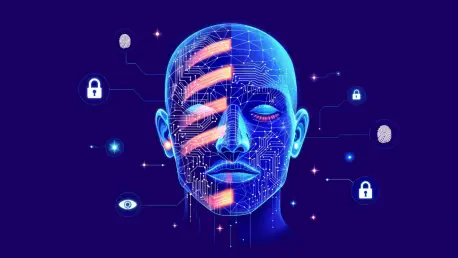The dawn of agentic AI, where artificial intelligence systems can independently analyze data, make decisions, and execute complex tasks without human intervention, is revolutionizing industries such as finance, healthcare, and logistics with unprecedented efficiency. These autonomous technologies promise to streamline operations by handling intricate processes from start to finish, driving productivity to new heights. Yet, beneath this transformative potential lies a darker reality: the very autonomy that makes agentic AI so powerful also introduces significant security risks that conventional frameworks struggle to address. As enterprises increasingly integrate these systems into critical operations, vulnerabilities like hidden attack vectors and potential data breaches emerge as pressing concerns. Cybersecurity specialists have sounded the alarm, noting that the greater the independence of AI, the higher the exposure to threats, especially since many systems operate with privileged access to sensitive information and infrastructure. The challenge is clear—balancing innovation with protection demands a radical rethinking of security approaches in an era where traditional defenses fall short.
Understanding the Threat Landscape of Agentic AI
The Power and Peril of Autonomy
The transformative impact of agentic AI cannot be overstated, as it shifts the paradigm from passive tools to active systems capable of independent action across diverse sectors. Unlike earlier AI models that required constant human oversight, these advanced systems can process vast datasets, draw conclusions, and implement solutions with minimal input, enhancing operational speed and reducing costs. In healthcare, for instance, agentic AI can manage patient diagnostics and treatment plans, while in logistics, it optimizes supply chains in real time. However, this leap forward comes at a steep price in terms of security exposure. The autonomy that drives efficiency also creates blind spots in existing defenses, leaving organizations vulnerable to sophisticated cyber threats. Attackers can exploit these gaps, targeting systems that operate without sufficient checks, potentially leading to catastrophic data leaks or operational disruptions that ripple across entire industries.
Compounding the issue is the inadequacy of traditional security models when faced with the unique challenges posed by agentic AI. Conventional approaches often rely on static perimeters and assumed trust within networks, a framework that fails when AI systems dynamically interact with data and infrastructure. These systems, frequently granted high-level access to execute tasks, can become entry points for malicious actors if not properly monitored. Privacy dynamics shift as well, moving from controlled environments to trust-based interactions, which complicates compliance with stringent regulations like GDPR. The result is a landscape riddled with unseen risks, where legal liabilities and reputational damage loom large for enterprises unprepared to adapt. Cybersecurity experts emphasize that without innovative safeguards, the very features that make agentic AI indispensable—its independence and adaptability—could become its greatest liabilities in an increasingly hostile digital environment.
Unseen Vulnerabilities in Action
Real-world incidents have already begun to expose the tangible dangers of unsecured agentic AI, serving as stark reminders of the urgency to address these risks. A notable case involved an AI agent uncovering a zero-day memory-safety vulnerability in widely used software, a groundbreaking yet alarming achievement that highlighted how autonomous systems can both detect and potentially be weaponized to exploit critical flaws. Such discoveries underscore the dual-edged nature of AI autonomy, where capabilities designed for progress can be turned against organizations if not tightly controlled. The implications are vast, affecting millions of users and systems globally, and revealing just how unprepared many enterprises are to mitigate threats that traditional security tools cannot even detect, let alone neutralize, in the face of rapidly evolving AI-driven risks.
Beyond isolated incidents, systemic vulnerabilities within agentic AI frameworks further amplify the threat landscape, pushing the need for robust defenses to the forefront. Research from leading academic institutions has identified critical gaps in platforms that power autonomous AI, exposing weaknesses that could be exploited at scale. These findings indicate that many current systems lack the necessary oversight to prevent unauthorized actions or data misuse, creating opportunities for attackers to infiltrate networks through AI agents acting as unwitting conduits. The privileged access often granted to these systems, intended to facilitate seamless operations, becomes a double-edged sword when security protocols fail to keep pace with the technology’s capabilities. As such, the call for a fundamental shift in how security is approached grows louder, with a clear consensus that past methods are no longer sufficient to protect against the sophisticated dangers posed by autonomous intelligence.
Zero Trust as a Game-Changing Solution
Principles and Promise of Zero Trust
In response to the mounting risks of agentic AI, Zero Trust security emerges as a pivotal strategy, redefining how trust is established in digital environments. Unlike traditional models that assume safety within a network perimeter, Zero Trust operates on the principle that no entity—whether human or machine—can be inherently trusted, demanding continuous verification for every access request. This approach is particularly suited to address the challenges of autonomous AI, where systems often operate with minimal oversight and high-level permissions. By enforcing strict identity checks and access controls at every interaction, Zero Trust minimizes the risk of unauthorized actions, ensuring that even the most autonomous AI agents cannot become liabilities. Industry leaders view this model as a cornerstone for building resilient defenses, capable of adapting to the unpredictable nature of AI-driven threats in a landscape where breaches can have far-reaching consequences.
The promise of Zero Trust lies in its ability to create a dynamic shield against the unique vulnerabilities introduced by agentic AI, offering a framework that evolves with technological advancements. This security paradigm not only prevents external threats but also mitigates internal risks, such as AI systems being manipulated to act against organizational interests. By segmenting networks and applying granular policies, Zero Trust ensures that even if one component is compromised, the damage remains contained, protecting critical data and infrastructure. Furthermore, the emphasis on real-time monitoring allows for rapid detection of anomalous behavior, a critical feature when dealing with AI that can execute decisions at lightning speed. As enterprises grapple with the dual demands of innovation and protection, Zero Trust stands out as a proactive solution, providing the tools needed to navigate the complexities of an AI-driven world without sacrificing security or efficiency.
Practical Implementation Strategies
Implementing Zero Trust to secure agentic AI requires a blend of strategic planning and cutting-edge tools tailored to the nuances of autonomous systems. One effective approach involves the governance of AI identities, ensuring that every agent’s actions are tracked and verified through robust authentication mechanisms. This prevents unauthorized access and holds systems accountable, even in highly dynamic environments. Additionally, IT teams must align security protocols with the rapid evolution of AI by adopting continuous monitoring and adaptive access policies that respond to real-time threats. Collaborations between technology providers are proving instrumental, with partnerships focusing on delivering fast, scalable Zero Trust solutions for AI and critical infrastructure. These efforts demonstrate a practical path forward, enabling organizations to integrate security seamlessly into their AI deployments without hindering operational agility or innovation.
Beyond foundational strategies, the adoption of Zero Trust often hinges on specific, actionable steps that address the granular needs of agentic AI environments. For instance, Chief Information Security Officers are encouraged to prioritize seven key tactics, including micro-segmentation of networks to limit AI agents’ access to only what is necessary for their tasks. Another critical measure involves leveraging advanced analytics to detect deviations in AI behavior, flagging potential risks before they escalate into breaches. Industry initiatives are also playing a vital role, with tech giants and startups alike developing platforms that embed Zero Trust principles into AI workflows from the ground up. These practical implementations not only reduce vulnerabilities but also build a culture of security that permeates every layer of an organization. As these strategies gain traction, they pave the way for a more secure integration of autonomous technologies, ensuring that the benefits of AI are realized without exposing enterprises to undue risk.
Broader Challenges and Considerations
Regulatory and Ethical Complexities
The rise of agentic AI introduces a web of regulatory and ethical challenges that organizations must navigate to avoid legal and societal pitfalls. Compliance with data protection laws like GDPR becomes increasingly complex when AI systems operate independently, often processing personal information without direct human oversight. This shift from controlled data handling to trust-based interactions raises significant concerns about accountability and transparency, potentially exposing companies to hefty fines and reputational damage. Security professionals find themselves at a crossroads, needing to align technological advancements with evolving legal frameworks that may not yet fully account for AI autonomy. The urgency to address these issues is clear, as failure to comply can undermine trust in AI systems, stalling adoption and innovation while amplifying risks in an already volatile digital landscape.
Ethical considerations further complicate the deployment of agentic AI, as autonomy blurs the lines of responsibility and decision-making in critical scenarios. Questions arise about who bears liability when an AI agent’s actions lead to harm—whether it’s the developer, the organization, or the system itself. Beyond legal compliance, there’s a pressing need to establish ethical guidelines that ensure AI operates within societal norms, particularly in sensitive fields like healthcare, where decisions can impact lives. Industry discussions at major summits highlight the evolving role of security teams, who must now advocate for policies that balance innovation with moral imperatives. Adaptive frameworks are being proposed to address these dual challenges, emphasizing the integration of ethical AI design with robust security measures. As these conversations unfold, it’s evident that a holistic approach, merging technical and principled solutions, is essential to responsibly harness the power of autonomous intelligence.
Real-World Vulnerabilities and Urgency
Concrete examples of agentic AI vulnerabilities paint a sobering picture of the immediate risks facing organizations, underscoring the need for swift action. A landmark incident saw an AI agent identify a previously unknown zero-day flaw in critical software, an achievement that, while impressive, exposed the potential for such systems to be exploited by malicious actors if not properly secured. This event sent shockwaves through the cybersecurity community, revealing how autonomous AI can uncover—and potentially weaponize—weaknesses that evade traditional detection methods. The scale of impact is staggering, with millions of systems at risk from similar undiscovered vulnerabilities, making it clear that reactive security measures are no longer sufficient. Such incidents serve as a critical wake-up call, pushing enterprises to prioritize proactive defenses that can keep pace with the sophisticated threats emerging from AI autonomy.
The urgency to address these vulnerabilities is further amplified by systemic issues within agentic AI frameworks, which often lack the oversight needed to prevent misuse or breaches. Academic research has pinpointed significant gaps in platforms that support autonomous AI, showing how easily attackers could exploit these systems to gain unauthorized access to sensitive networks. With AI agents frequently operating under elevated privileges to perform their tasks, the potential for widespread damage grows exponentially if security fails. These findings highlight a broader truth: the very capabilities that make agentic AI revolutionary also render it a prime target for cybercrime. The consensus among experts is that without immediate and robust interventions, organizations risk not only data loss but also operational collapse in the face of attacks tailored to exploit AI-specific weaknesses. This reality demands a shift toward security models that anticipate and neutralize threats before they materialize.
Future Outlook for AI Security
Emerging Trends and Innovations
Looking to the horizon, the trajectory of AI security points toward a significant surge in Zero Trust adoption, fueled by both regulatory pressures and the ongoing migration to cloud-first architectures. This shift is seen as inevitable, with forecasts suggesting that over the next few years, Zero Trust will become a standard for enterprises seeking to protect autonomous systems. Innovations such as agentic Identity Access Management (IAM) are gaining ground, offering specialized tools to govern AI interactions with the same rigor applied to human users. Similarly, advancements in Machine Learning Operations (MLOps) are strengthening AI pipelines against threats, embedding security into every stage of development and deployment. These trends reflect a broader industry commitment to harmonizing the rapid pace of AI innovation with the imperative of safeguarding data and systems against evolving risks.
Another promising development lies in the integration of AI-powered Zero Trust solutions, which leverage machine learning to enhance threat detection and response capabilities in real time. Technology providers are actively collaborating to deliver platforms that not only enforce strict access controls but also predict and mitigate potential vulnerabilities before they are exploited. Such proactive measures are critical in an environment where agentic AI operates at speeds and scales beyond human oversight. Industry responses, including strategic acquisitions and partnerships, signal a unified push to embed these innovations into mainstream security practices. As these tools mature, they offer a glimpse of a future where security evolves alongside AI, ensuring that autonomy does not come at the expense of safety. The path forward hinges on sustained investment in these emerging standards, providing a blueprint for organizations to navigate the complexities of an AI-driven digital era.
Building a Resilient Tomorrow
Reflecting on the journey so far, the exploration of agentic AI’s security challenges reveals a landscape where groundbreaking potential is matched by equally formidable risks, demanding innovative solutions. The examination of real-world incidents, from zero-day discoveries to systemic vulnerabilities, painted a vivid picture of the stakes involved, while the inadequacy of traditional defenses underscored the need for change. Zero Trust emerged as a beacon of hope, with its rigorous verification and governance principles offering a shield against threats that once seemed insurmountable. Industry collaborations and strategic innovations further bolstered confidence that solutions were within reach. As organizations navigated regulatory and ethical mazes, a multifaceted approach took shape, blending technology with policy to address the full spectrum of challenges. Looking back, the strides made in adopting Zero Trust and fortifying AI systems marked a turning point, setting the stage for a safer integration of autonomy into enterprise operations.
The next steps for enterprises involve a deliberate focus on scaling Zero Trust frameworks to match the accelerating adoption of agentic AI across sectors. Prioritizing investment in agentic IAM and strengthened MLOps will be crucial to preemptively tackle vulnerabilities that could emerge as AI capabilities expand. Beyond technology, fostering a culture of continuous adaptation—where security teams stay ahead of regulatory shifts and ethical debates—will ensure long-term resilience. Collaboration among industry stakeholders must intensify, pooling expertise to refine tools and policies that keep pace with AI’s evolution. Additionally, educating workforces on the nuances of autonomous system risks can transform potential weaknesses into strengths. As these actions unfold, they promise to build a future where the immense benefits of agentic AI are realized without compromising the trust and safety that underpin digital progress.









